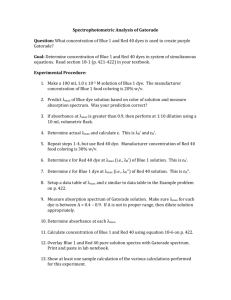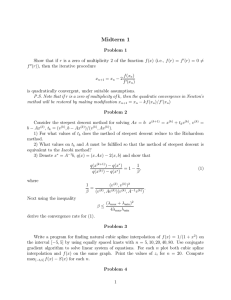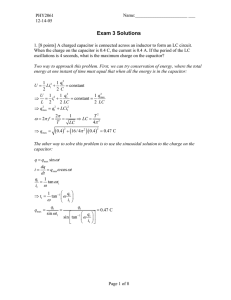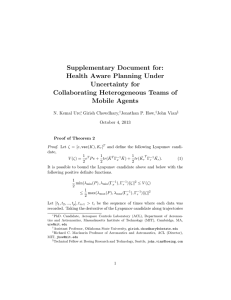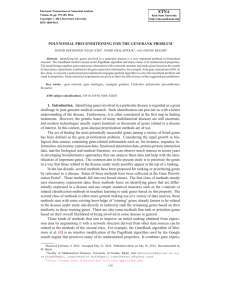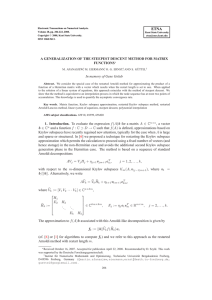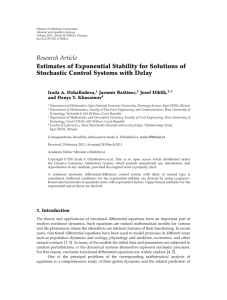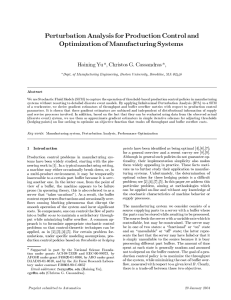Gen. Math. Notes, Vol. 2, No. 1, January 2011, pp.... Copyright °ICSRS Publication, 2011 www.i-csrs.org
advertisement
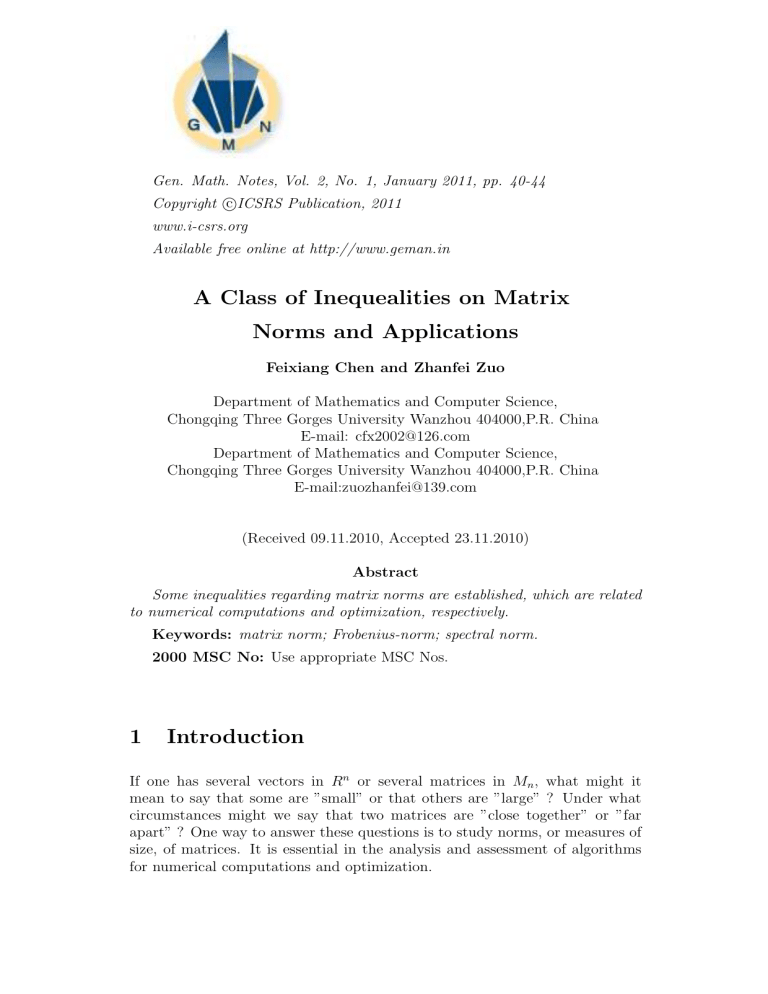
Gen. Math. Notes, Vol. 2, No. 1, January 2011, pp. 40-44 c Copyright °ICSRS Publication, 2011 www.i-csrs.org Available free online at http://www.geman.in A Class of Inequealities on Matrix Norms and Applications Feixiang Chen and Zhanfei Zuo Department of Mathematics and Computer Science, Chongqing Three Gorges University Wanzhou 404000,P.R. China E-mail: cfx2002@126.com Department of Mathematics and Computer Science, Chongqing Three Gorges University Wanzhou 404000,P.R. China E-mail:zuozhanfei@139.com (Received 09.11.2010, Accepted 23.11.2010) Abstract Some inequalities regarding matrix norms are established, which are related to numerical computations and optimization, respectively. Keywords: matrix norm; Frobenius-norm; spectral norm. 2000 MSC No: Use appropriate MSC Nos. 1 Introduction If one has several vectors in Rn or several matrices in Mn , what might it mean to say that some are ”small” or that others are ”large” ? Under what circumstances might we say that two matrices are ”close together” or ”far apart” ? One way to answer these questions is to study norms, or measures of size, of matrices. It is essential in the analysis and assessment of algorithms for numerical computations and optimization. 41 A class of inequealities on matrix 2 notation and terminology Throughout this paper, uppercase roman letters denote matrices, lowercase roman letters denote vectors, and lowercase Greek letters denote scalars. We let Rn denote the set of n-dimensional vectors having real components. Also,we let Mn denote the set of n × n matrices with real entries. For a matrix Q ∈ Mn with all real eigenvalues, we denote its eigenvalues by λi [Q], i = 1, . . . , n, and its smallest eigenvalue and largest eigenvalue by λmin [Q] and λmax [Q], P respectively. The trace of a matrix Q ∈ Mn is denoted by trQ ≡ ni=1 Qii . The set of all symmetric n × n is denoted by S n . The Euclidean norm and its associated operator norm are both denoted by k · k. Definition 2.1 A function k · k : Mn → R is called a matrix norm if for all A, B ∈ Mn when it satisfies the following axioms: (1) kAk ≥ 0, with equality holding if and only if A = 0; (2) kαAk = αkAk, for all complex scalar α; (3) kA + Bk ≤ kAk + kBk, for all A, B ∈ Mn ; (4) kABk ≤ kAkkBk, for all A, B ∈ Mn . Definition 2.2 The Frobenius norm defined for A ∈ Mn by kAkF ≡ ( n X |aij |2 )1/2 . i,j=1 Definition 2.3 Let k · k be a vector norm on Rn . Define operator norm or spectral norm k · k on Mn by q kAk ≡ maxkxk=1 kAxk = 3 λmax (AT A). The Main Results In the next result, we collect some useful facts about symmetric matrices. For its proof, we refer the reader to Golub and Van Loan [1] or Horn and Johnson [2]. In the next result, we collect some useful facts about symmetric matrices. For its proof, we refer the reader to Golub and Van Loan [1] or Horn and Johnson [2]. Lemma 3.1 For all E ∈ S n , we have: λmax (E) = maxkuk=1 uT Eu.. (1) λmin (E) = minkuk=1 uT Eu.. (2) kEk = maxi=1,...,n |λi (E)|. (3) kEk2F = n X i=n [λi E]2 . (4) 42 Feixiang Chen and Zhanfei Zuo Lemma 3.2 For all A ∈ Mn , the following relations hold: 1 maxi=1,...,n Re[λi (A)] ≤ λmax (A + AT ). 2 (5) 1 mini=1,...,n Re[λi (A)] ≥ λmin (A + AT ). 2 (6) n X |λi (A)|2 ≤ kAk2F = kAT k2F ; (7) i=1 λmax (AT A)k = kAT Ak = kAk2 = kAT k2 . (8) Proof. Inequality (5) is stated as an exercise in Horn and Johnson; see [1]. Inequality (6) follows from (5) applied to the matrix −W . To prove (7), we prove that tr(A2 ) ≤ tr(AT A). we first consider the case n = 2, " A= a11 a12 a21 a22 # . hence, tr(A2 ) = a211 + a222 + 2a11 a22 ≤ a211 + a222 + a212 + a222 = tr(AT A). We consider n = k and n = k + 1, respectively. " A= B αk β k ak+1,k+1 # . where B ∈ Mk and αk , β k ∈ Rk . Then, tr(A2 ) = tr(B 2 )+2(β k )T αk +a2k+1,k+1 ≤ tr(B 2 ) + a2k+1,k+1 + kβ k k2 + kαk k2 = tr(AT A). Hence, (7) holds. Considering that AT A ∈ S n , which clearly implies (8). Lemma 3.3 Suppose that W ∈ Mn is a nonsingular matrix. then for any E ∈ S n , the following relations hold: 1 λmax (E) ≤ λmax (W EW −1 + (W EW −1 )T ). 2 (9) 1 λmin (E) ≥ λmin (W EW −1 + (W EW −1 )T ). 2 (10) Proof. Using (5), we obtain 1 λmax (E) = λmax (W EW −1 ) ≤ λmax (W EW −1 + (W EW −1 )T ) 2 for every E ∈ Mn , and hence (9) follows. Inequality (10) is proved in a similar way by using (6). . 43 A class of inequealities on matrix 4 Applications The following inequalities are widely used in numerical computations and optimization [3]. Lemma 4.1 For every A ∈ Mn , and H ∈ Sn , then the equations AU + U A = H has a unique solution U ∈ Sn . Moveover, this solution satisfies √ kAU kF ≤ kHkF / 2. (11) (12) Proof.The first part of the lemma follows from the fact that the linear map ΦA : Sn → Sn defined by ΦA (U ) : AU + U A is an isomorphism. Indeed, since ΦA has the same domain and codomain, it suffices to show that ΦA is one-to-one, or equivalently that AU + U A = 0 implies U = 0. In turn, this last implication follows from the fact that any solution U of (11) satisfies (12) (simply set H = 0 in (12) to conclude that U = 0). To show the last claim, we square both sides of (11) to obtain 2kAU k2F + 2tr(U AU A) = kHk2F . Since tr(U AU A) = kA1/2 U A1/2 k2F ≥ 0, then we complete the proof. Lemma 4.2 Suppose that W ∈ Mn is a nonsingular matrix. then for any E ∈ S n , the following relations hold: 1 kEk ≤ kW EW −1 + (W EW −1 )T k. 2 (13) 1 kEkF ≤ kW EW −1 + (W EW −1 )T kF . 2 (14) Proof.Using (5), we obtain 1 λmax (E) = λmax (W EW −1 ) ≤ λmax (W EW −1 + (W EW −1 )T ) 2 and 1 λmin (E) = λmin (W EW −1 ) ≥ λmin (W EW −1 + (W EW −1 )T ). 2 Then we conclude that 1 1 λmin (W EW −1 +(W EW −1 )T ) ≤ λmin (E) ≤ λmax (E) ≤ λmax (W EW −1 +(W EW −1 )T ). 2 2 44 Feixiang Chen and Zhanfei Zuo From kEk = kλi (E)k, i = 1, 2, . . . , n, then we prove the first part. To prove (14) , we use (4) and (7) to get kEk2F = n X [λi (E)]2 = i=1 n X [λi (W EW −1 )] ≤ (W EW −1 )|2F . i=1 Hence, we obtain 4kEk2F ≤ = = = = 2kEk2F + 2kW EW −1 k2F 2kW EW −1 k2F + 2tr(E 2 ) 2kW EW −1 k2F + 2tr(W E 2 W −1 ) 2kW EW −1 k2F + 2tr(W EW −1 )2 kW EW −1 + (W EW −1 )T k2F . Which clearly implies (14). Theorem 4.3 For all A ∈ Mn , the following relations hold: 1 kA + AT kF ≤ kAkF ; . 2 (15) 1 kA + AT k ≤ kAk.. 2 (16) Proof. The two inequalities can be proved by using the triangle inequality for norm. References [1] R A Horn and C R Johnson, Topics in matrix analysis, New York: Cambridge University Press, (1991). [2] Horn G. H. Golub and C. E. Vanloan, Matrix computations: Second Edition, The John Hopkins University Press, Baltimore, MD, (1989). [3] A.A. Soliman, Primal-dual following interior point algorithms for semidefinite programming. SIAM J Optimization 7(3) (1997) 663–678.

